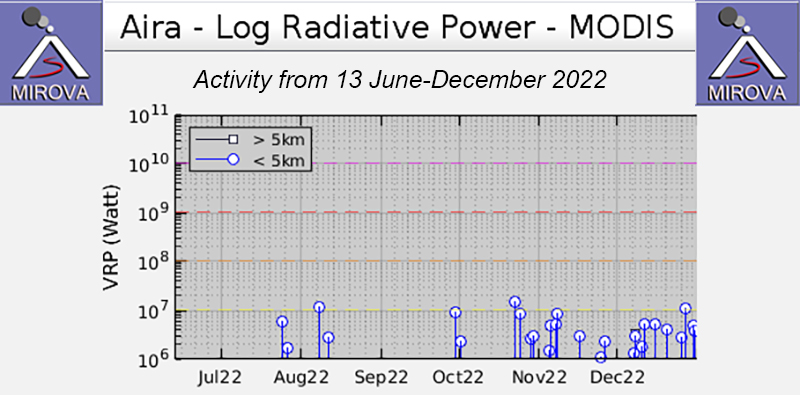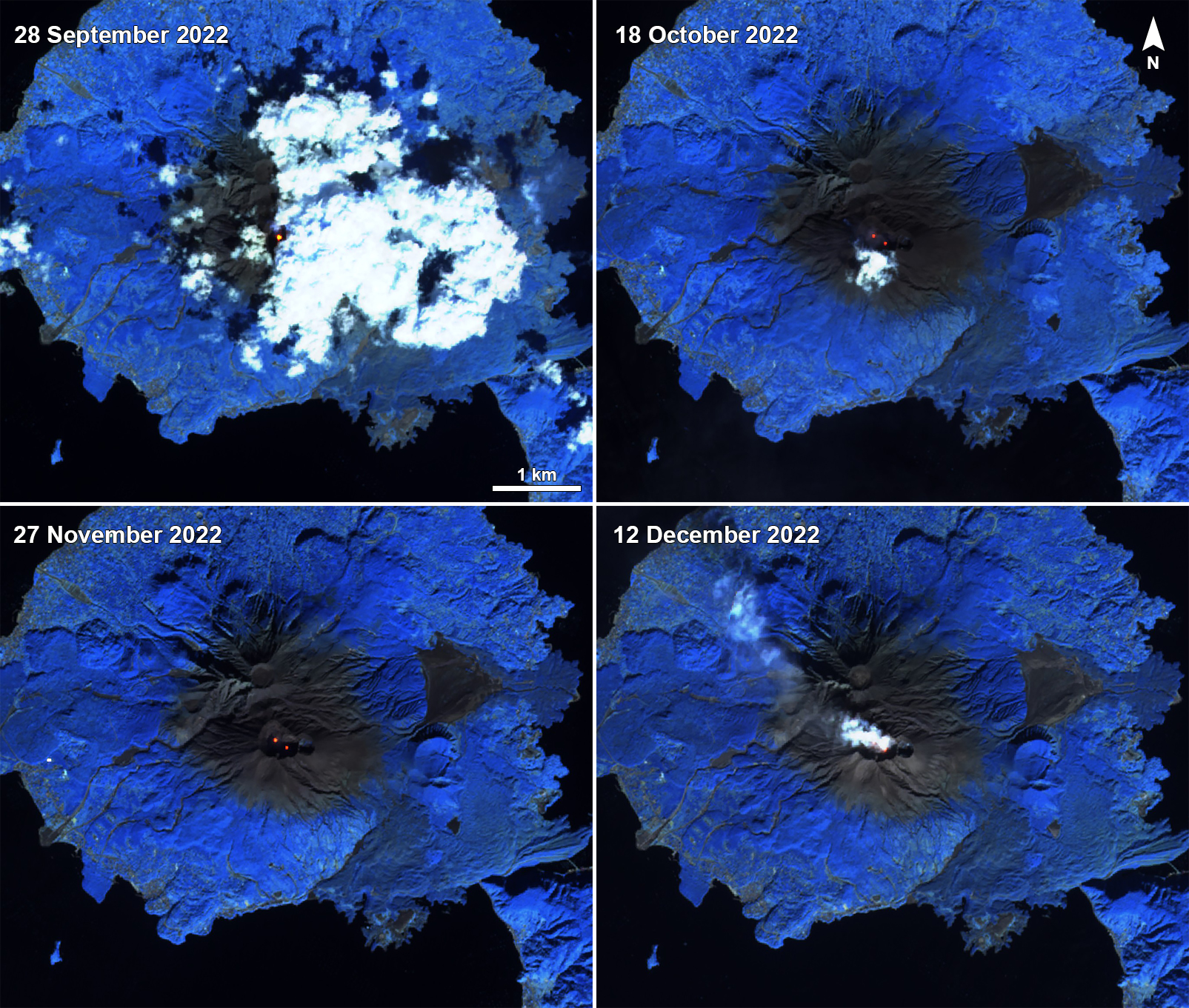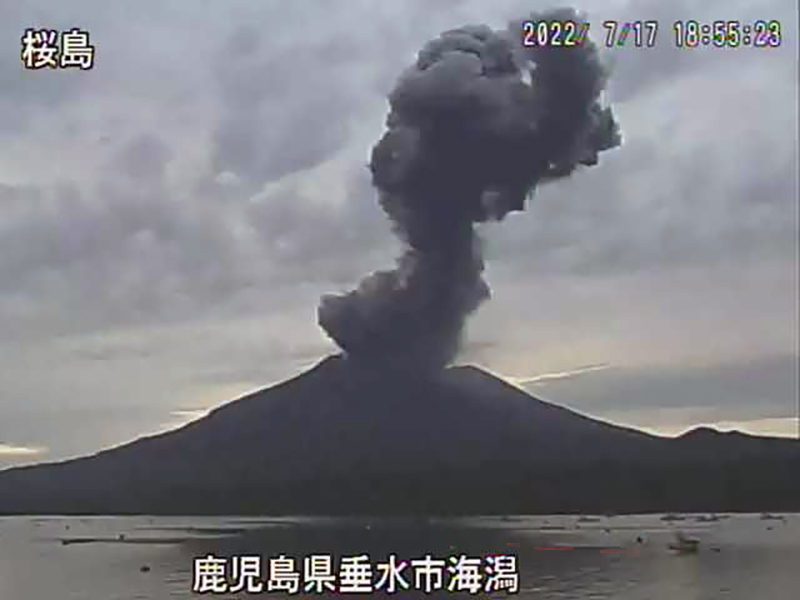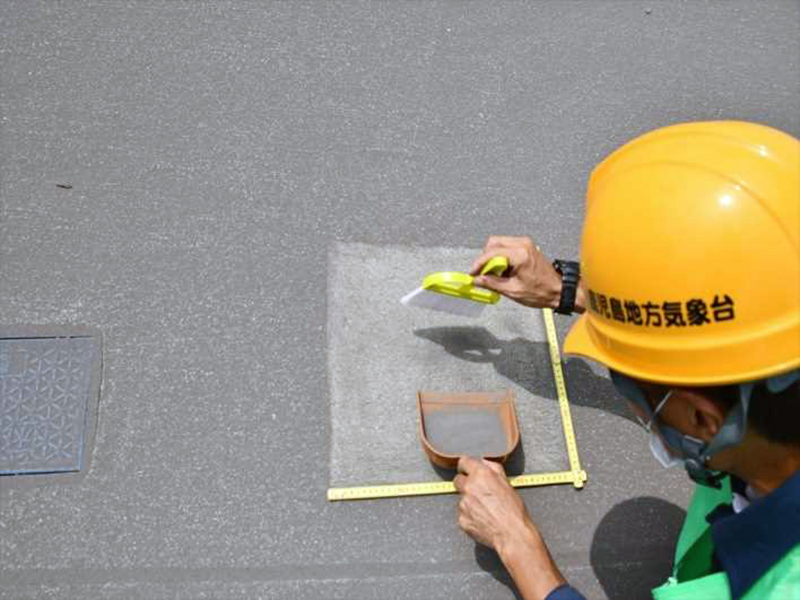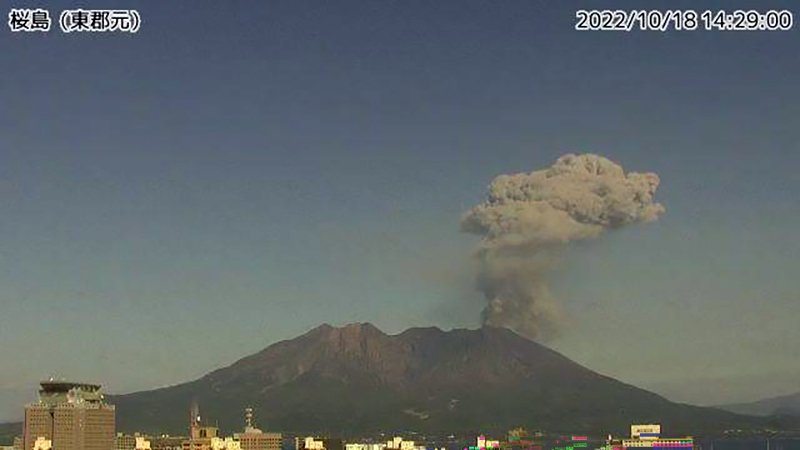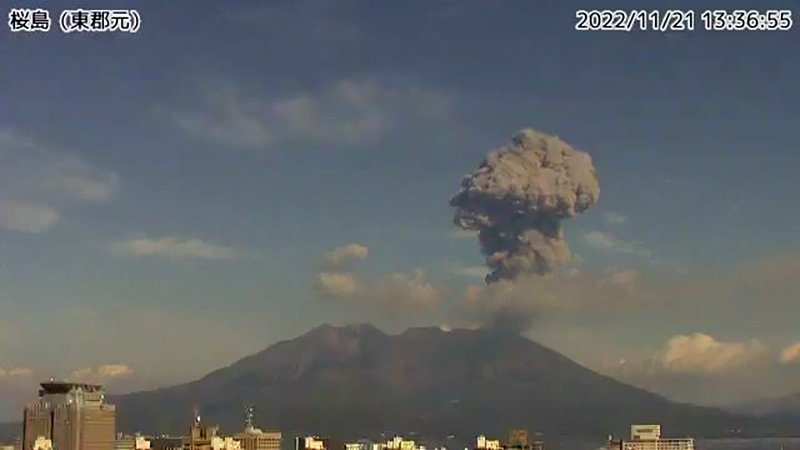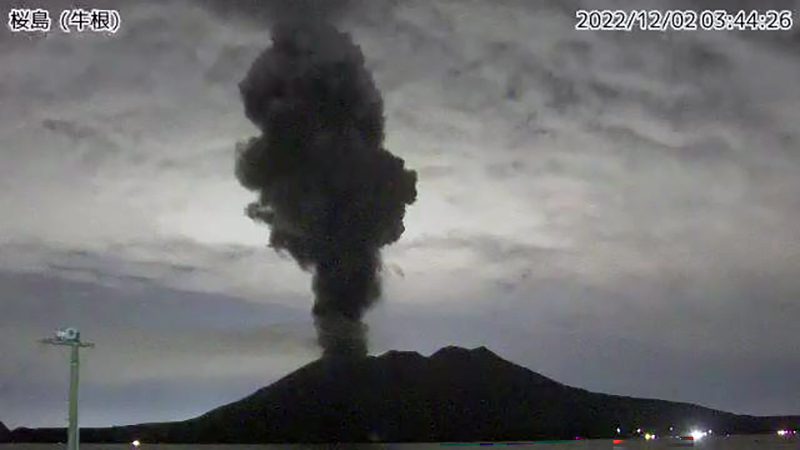Report on Aira (Japan) — January 2023
Bulletin of the Global Volcanism Network, vol. 48, no. 1 (January 2023)
Managing Editor: Edward Venzke.
Edited by Kadie L. Bennis.
Aira (Japan) Explosions, ash plumes, and ashfall during July-December 2022
Please cite this report as:
Global Volcanism Program, 2023. Report on Aira (Japan) (Bennis, K.L., and Venzke, E., eds.). Bulletin of the Global Volcanism Network, 48:1. Smithsonian Institution.
Aira
Japan
31.5772°N, 130.6589°E; summit elev. 1117 m
All times are local (unless otherwise noted)
Aira caldera is located in the northern half of Kagoshima Bay and contains the active post-caldera Sakurajima volcano near the southern tip of Japan’s Kyushu Island. Frequent historical eruptions have been recorded since the 8th century and have deposited ash on Kagoshima, one of Kyushu’s largest cities, 10 km W from the summit. The largest recorded eruption took place during 1471-76. The current eruption period began during late March 2017 and has more recently consisted of explosive events, eruption plumes, minor ashfall, and crater incandescence (BGVN 47:07). This report updates information from July through December 2022 using monthly activity from the Japan Meteorological Agency (JMA) and satellite data.
Thermal activity remained at low levels during the reporting period; only two anomalies were detected each month during late July and early August, and there was a brief period of no registered thermal data during mid-August through most of September (figure 132). After late October, the frequency of thermal anomalies increased slightly and up to two anomalies were observed in the Minamidake crater in Sentinel-2 infrared satellite imagery during the latter part of the year (figure 133).
Table 28. Number of monthly explosive events, days of ashfall, area of ash covered, and sulfur dioxide emissions from Sakurajima’s Minamidake crater at Aira during July-December 2022. Note that smaller ash events are not listed. Ashfall days were measured at Kagoshima Local Meteorological Observatory, and ashfall amounts represent material covering all the Kagoshima Prefecture. Data courtesy of JMA monthly reports.
| Month | Explosive events | Days of ashfall | Ashfall amount (g/m3) | SO2 emissions (tons/day) |
| Jul 2022 | 12 | 6 | 28 | 1,400-3,200 |
| Aug 2022 | 16 | 0 | 0 | 1,500-2,500 |
| Sep 2022 | 23 | 14 | 53 | 1,900-2,400 |
| Oct 2022 | 12 | 18 | 24 | 1,900-4,000 |
| Nov 2022 | 5 | 10 | 9 | 700-1,900 |
| Dec 2022 | 11 | 8 | 12 | 1,400-2,800 |
JMA reported that during July there were 37 eruption events detected, 12 of which were explosion events. Accompanying eruption plumes rose 2.8 km above the crater rim. Nighttime incandescence was observed in the Minamidake crater using a high-sensitivity surveillance camera. No eruptions in the Showa crater were reported. Seismicity consisted of 146 volcanic earthquakes, which had increased compared to 57 earthquakes in June. According to field surveys, daily sulfur dioxide emissions ranged 1,400-3,200 tons/day (t/d). The Kagoshima Local Meteorological Observatory reported a total of 28 g/m2 of ashfall was observed during 6 days. On 17 July an explosion at 1852 generated an eruption plume that rose 2.8 km above the crater rim and large volcanic blocks were ejected 800-1,100 m above the crater rim (figure 134).
JMA reported an inflation event was first detected around 0900 on 18 July and warned residents that an inflation event suggested a magmatic intrusion was occurring. A field visit reported that sulfur dioxide emissions were at 1,900 t/d. Four eruptive events were recorded between 23 July and 1500 on 24 July that produced plumes that rose 1.2 km above the crater rim. A larger explosion at 2005 on 24 July ejected large volcanic blocks 2.4-2.5 km E. The accompanying volcanic plume rose 300 m above the crater rim and mixed with meteoric clouds. The last time an explosion ejected material more than 2 km from the crater was on 4 June 2020, according to JMA. The Volcano Alert Level (VAL) was briefly raised from 3 to 5 (on a 5-level scale) at 2050, signaling that the residents should evacuate. Ashfall was reported in Kagoshima City (10 km W). JMA noted that inflation stopped after this event. A field survey was conducted by the Japan Meteorological Agency Mobile Survey Team (JMA-MOT) on 25 July and confirmed that material was deposited more than 2.4 km from the vent, and they observed ashfall in an area from Shirahamacho (42 km NW) to Kurokamicho (5 km SE). Ash was deposited on the E flank of the Minamidake crater, based on data from infrared thermal imaging equipment and visual observations (figure 135). During 25-26 July a few small explosions and eruptive events generated plumes that rose as high as 2.2 km above the crater rim and disappeared into meteoric clouds. After 26 July, JMA noted that material had not been ejected more than 2 km from the crater, so the VAL was lowered back to 3.
There were 71 eruptions reported during August, 16 of which were explosions. Volcanic plumes rose 2.8 km above the crater rim. Nighttime crater incandescence was observed at the Minamidake crater. There were 207 volcanic earthquakes detected during the month. According to a field survey the amount of sulfur dioxide emissions released ranged between 1,500-2,500 t/d. Ashfall was not observed. On 2 August at 0055 a volcanic plume rose 2.8 km above the crater. On 15 August at 0009 an explosion produced an eruption plume that rose 2 km above the crater rim and ejected large blocks 1.3-1.7 km above the summit.
During September there were 36 eruption events and 23 of which were explosions. Volcanic plumes rose 2.8 km above the crater rim and nighttime crater incandescence persisted. There were 319 volcanic earthquakes detected during the month. Sulfur dioxide emissions ranged between 1,900-2,400 t/d. According to the Kagoshima Local Meteorological Observatory, a total of 53 g/m2 ashfall was observed over 14 days. On 23 September at 1335 a volcanic plume rose 1.7 km above the crater rim and continued until 1600. Some ashfall was observed on the SE flank. On 30 September at 1144 an explosion rose 2.8 km above the crater rim and drifted down-flank to the SE until 1600. A large amount of ash was deposited on the SE flank. Around 0000 volcanic blocks were ejected 1.3-1.7 km from the Minamidake crater.
Eruptive activity continued during October, with 39 events reported, which included 12 explosions. Volcanic plumes rose 2.4 km above the crater rim. Nighttime crater incandescence continued. Seismicity consisted of 145 volcanic earthquakes. According to a field survey, the amount of sulfur dioxide released during the month ranged from 1,900 t/d to 4,000 t/d, the latter of which was measured on 14 October. JMA noted that the amount of volcanic gas released has been generally high since July. Ashfall measurements showed that a total of 24 g/m2 fell over 18 days at the Kagoshima Local Meteorological Observatory. An explosion was detected at 1932 on 10 October that ejected material 1.3-1.7 km from the Minamidake summit crater. A field survey conducted on 11 October confirmed weak incandescence was visible in the Minamidake crater and a geothermal area was observed on the SE flank of Minamidake, part of the inner Showa crater wall. At 1424 on 18 October an eruption plume rose 2.4 km above the crater (figure 136). Smaller eruptive events were occasionally recorded during 28-31 October.
JMA reported 17 eruptive events occurred during November, which included 5 explosions. Volcanic plumes rose 2.2 km above the crater rim. Nighttime crater incandescence was reported in the Minamidake crater. There were 135 volcanic earthquakes detected throughout the month. The amount of sulfur dioxide emissions ranged from 700 t/d to 1,900 t/d and a total amount of 9 g/m2 of ashfall was observed at the Kagoshima Local Meteorological Observatory over 10 days. Explosions were detected at 0515 on 4 November and 1954 on 20 November and ejected volcanic blocks 600-900 m. An explosion at 2010 on 15 November generated a volcanic plume that rose 600 m above the crater rim and drifted SE. An explosion at 1334 on 21 November generated an eruption plume that rose 2.2 km above the crater rim and ejected large blocks as far as 500 m from the vent (figure 137). Small eruptive events were also detected during 25-28 November.
During December, JMA reported that there were 20 eruptions, 11 of which were explosions. Volcanic plumes rose as high as 3.2 km above the crater rim. Nighttime crater incandescence remained visible at the Minamidake crater. There were 78 volcanic earthquakes detected during the month. According to a field survey the amount of sulfur dioxide emissions released was 1,400-2,800 t/d. During the month, 12 g/m2 of ash fell over 8 days during the month, as observed at the Kagoshima Local Meteorological Observatory. At 0340 on 2 December a volcanic plume rose 3.2 km above the crater rim and ejected blocks as far as 1.1 km from the vent (figure 138). A second explosions was detected at 1929 on 3 December that produced an eruption plume that rose 3 km above the crater rim and ejected volcanic blocks 1-1.3 km from the crater. Webcam video of the event showed incandescent material ejected above the crater and lightning in the ash plume. Two explosions were recorded on 14 December that generated eruption plumes rising 1.7 km above the crater rim and disappearing into the meteoric clouds. Ejected blocks traveled as far as 700 m from the vent. An explosion at 0805 on 17 December produced a plume that rose 700 m above the crater rim and interacted with meteoric clouds. Ejected blocks traveled 900 m from the vent. At 0449 on 22 December ejected blocks traveled 600-900 m from the vent. On 24 December at 1954 an explosion produced an eruption plume that rose 1.2 km above the crater rim and ejected large blocks as far as 1.1 km from the vent. Two explosions on 27 and 29 December generated volcanic plumes 1.7 km above the crater rim and ejected blocks as far as 900 m from the vent.
Geological Summary. The Aira caldera in the northern half of Kagoshima Bay contains the post-caldera Sakurajima volcano, one of Japan's most active. Eruption of the voluminous Ito pyroclastic flow accompanied formation of the 17 x 23 km caldera about 22,000 years ago. The smaller Wakamiko caldera was formed during the early Holocene in the NE corner of the caldera, along with several post-caldera cones. The construction of Sakurajima began about 13,000 years ago on the southern rim and built an island that was joined to the Osumi Peninsula during the major explosive and effusive eruption of 1914. Activity at the Kitadake summit cone ended about 4,850 years ago, after which eruptions took place at Minamidake. Frequent eruptions since the 8th century have deposited ash on the city of Kagoshima, located across Kagoshima Bay only 8 km from the summit. The largest recorded eruption took place during 1471-76.
Information Contacts: Japan Meteorological Agency (JMA), 1-3-4 Otemachi, Chiyoda-ku, Tokyo 100-8122, Japan (URL: http://www.jma.go.jp/jma/indexe.html); MIROVA (Middle InfraRed Observation of Volcanic Activity), a collaborative project between the Universities of Turin and Florence (Italy) supported by the Centre for Volcanic Risk of the Italian Civil Protection Department (URL: http://www.mirovaweb.it/); Sentinel Hub Playground (URL: https://www.sentinel-hub.com/explore/sentinel-playground).


